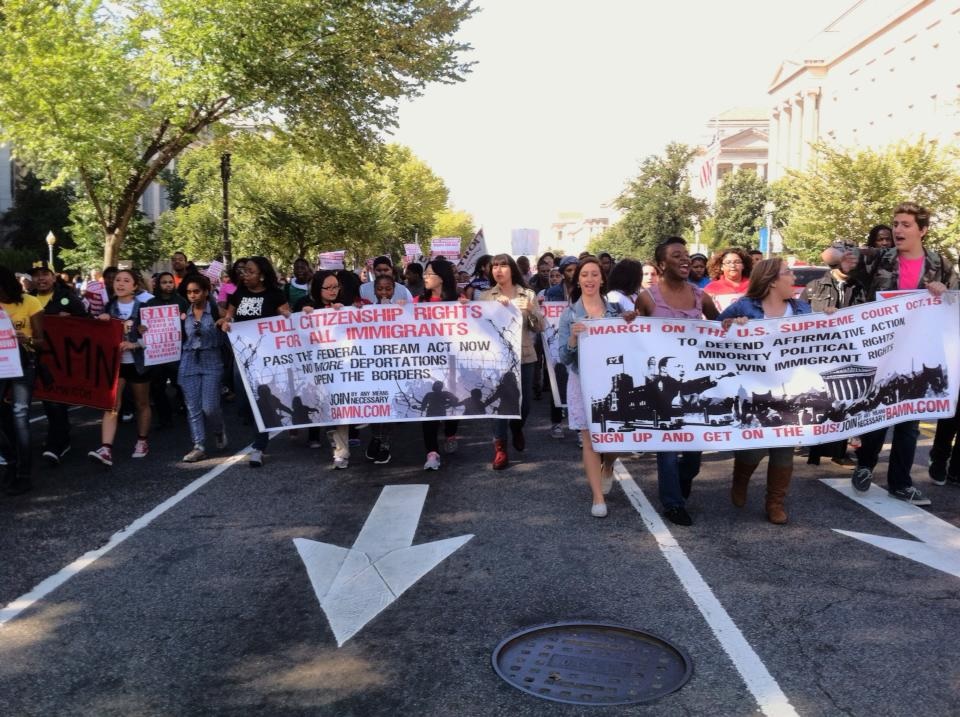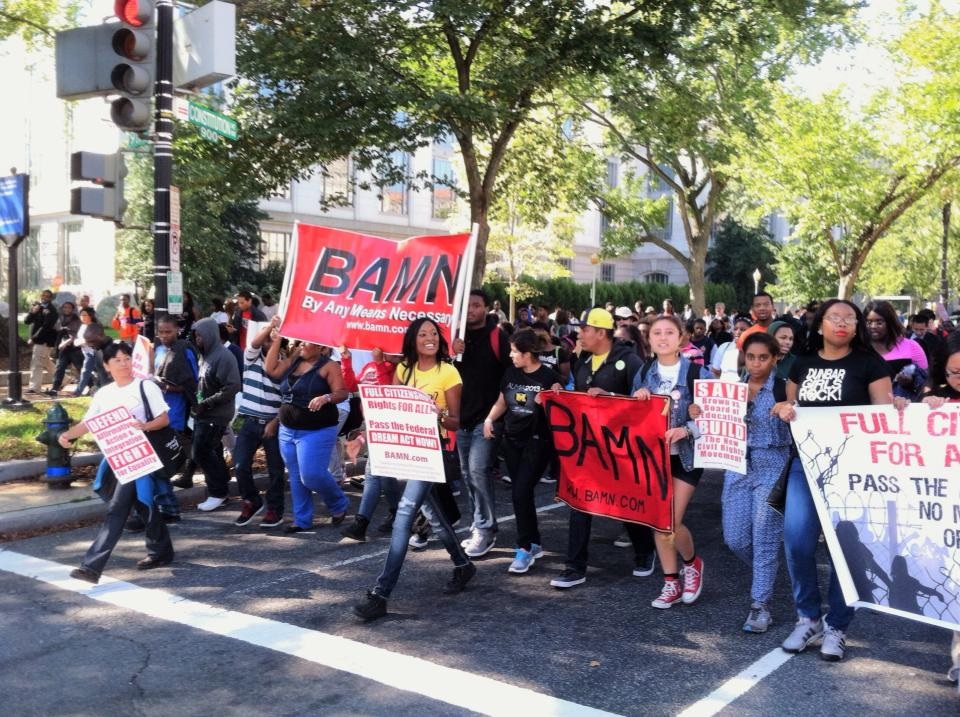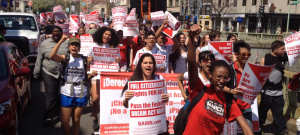Trump’s Attacks on Democracy Are Real and Immediate
The Resistance to Trump Must Mobilize to Defend Democracy Now — With All Its Strength
For a Printable Flyer of this Post, Click HERE
I. Understanding our tasks
Defending America’s democracy urgently requires:
1. The Resistance must support Tom Steyer’s campaign to impeach Trump, convict Trump, and remove Donald Trump from office, using the only provision in the Constitution designed to protect the people against tyranny.
2. The Resistance must defend the Mueller investigation, which, in the face of a slavish and impotent Congress, has been the only process in our government actually presenting any struggle against Trump. Shutting down the Mueller investigation is Trump’s main plan to shut down impeachment. If the Resistance cannot defend Mueller, the impeachment process will be sabotaged and the likelihood of ever impeaching and removing Trump will approach zero.
3. The Resistance must recognize the extreme importance of the struggle over confirming Brett Kavanaugh to the U.S. Supreme Court. If Trump is able to achieve the confirmation of Kavanaugh, he will have taken over the third branch of government and also guaranteed his ability to also shut down Mueller. If Kavanaugh is confirmed, the Mueller investigation is essentially dead, and the road to impeachment is sabotaged.
4. The Resistance needs to understand clearly that Trump and his movement have an ideology, a real program of political action for the United States of America. This is true despite Trump’s own evident stupidity and incompetence and the divisions and confusion in his movement. Its aim is to create an American government completely subservient to the interests of a section of America’s giant corporations and wealthiest individuals, without any meaningful constitutional or democratic restraints on the use of governmental power to serve their purposes, both domestically and in international policy. The view of these interests is that the preservation of their gargantuan wealth and power requires the conversion of the American political system into a form of government much more like that of America’s current rivals, Russia and China.
Domestically, this requires a suppression of traditional labor and workers’ rights and civil rights generally. Internationally, this requires a government committed, regardless of the immediate harm done to millions of American producers, to a policy of aggressive trade war, especially against China, intensified militarism, recognizing that any trade war must be backed up by the threat of actual military conflict, and the restructuring of an American system of alliances to favor relations with other authoritarian and despotic regimes with similar “state-capitalist” and authoritarian structures.
Over the course of the Trump presidential campaign, it became increasingly clear that Trump and his most conscious advisers and handlers were convinced that achieving the kind of regime his most fervent capitalist backers sought required, in a country like the United States, the creation of a mass movement supporting Trump that had somehow been convinced to support the suppression of their own democratic freedoms on behalf of a small number of capitalist corporations and plutocrats. Trump and his ideological entourage understood that, in American history, the way to do that is to appeal to racist and xenophobic paranoias.
In Trumpism, as with the European neo-fascist parties and movements, a domestic policy based on white-racist and ultra-nationalist demagogy, leads naturally, almost inevitably, to the international policy of an alliance with and support for the most important European power embodying an authoritarian and white-nationalist outlook: Russia under Putin. However illogical, irrational, and inconsistent the policy may appear to be, all these far-right, ultra-nationalist, white-racist parties and movements internationally, including Trump’s, share the image of a racialized foreign policy centered on an alliance with Putin, with an implied fantasy that only through such an alliance of white governments based on white people’s support can the “white” nations of the world prevent the rise to global domination of non-white nations—specifically China.
Some of Trump’s supporters call this domestic policy “anarcho capitalism.” Some view the creation of a racist and xenophobic mass movement as a secondary question, a necessity, even an unfortunate one, in order to achieve the central aim of an authoritarian government committed without limits to use all the means at its disposal to protect and enlarge capitalist wealth and power. Government by the people must be replaced with government for the rich and powerful, but to achieve this, a section of the people must be duped with racism into supporting an authoritarian regime. It is obvious that the great majority of Trump’s supporters, the overwhelming majority of Trump’s electoral base, are fanatically committed to him, not by his program of profoundly increasing the power of the rich and powerful, but by his sick, seductive promise of recreating an America in which white people rule and white-skin privilege defines American citizenship.
Whether this program is called “anarcho capitalism,” ultra-nationalism, white nationalism, anti-globalism, or any other of the more-or-less incomplete and misleading terms that are favored both by Trump’s supporters and his liberal political, journalistic, and academic critics, this perspective, taken as a whole, placed in the context of the growing number of organizations and leaders committed to essentially similar perspectives in countries across Europe, is essentially the twenty-first century form of fascism. This perspective plays the same role in history, is structured with the same dangerous logic, and is aimed at achieving essentially the same ends as the doctrines of Mussolini and Hitler in the first half of the twentieth century.
5. To rise to its own historic challenge, the Resistance needs to understand that its task is not merely to end the political career of one particularly gross and odious American politician. Its challenge is to block, with democratic, bold, and courageous methods, the confused but supremely arrogant, determined, and dangerous ambitions of a fascist movement to come to power in the United States and across Europe.
As before, such a movement can only come to power and hold power on the dead body of democratic rights and the actual bodies of millions of people.
6. The question of whether Donald Trump himself should be called a fascist, may still be open. The Resistance needs to understand that this is not the important question. The historical process we are going through is most truthfully and profoundly understood as a process of fascist transformation. Blocking that process requires the decisive defeat and removal of Trump from the American presidency, by whatever means are necessary, because the survival of the democratic character of the country and the world are at stake. For the Resistance, it is no time for denial, evasions, self-deception, timidity, cynicism, pettiness, or any form of “business as usual.”
The people of America are facing an historic crisis, and they will have to rise to an historic challenge in order to resolve it. The mass Resistance to Donald Trump is the means history has so far created to meet this challenge. To do so, this new movement first needs to recognize the character of the challenge, affirm its belief in its ability to meet that challenge, and then learn what that will mean in practice.
II. Learning how to win
Objectively, the vast movement of the Resistance has the potential power to defeat Trump’s attacks on American democracy and to block the coming to power of a new fascist movement, but to make this potential power real, the Resistance must be able to draw certain lessons from history and embrace certain principles as the basis of its historic struggle.
1. The Resistance must recognize how powerful it really is and see its own development as the key to victory, not the “business as usual” counsel of self-annointed leaders who see themselves as above the movement and think being a part of the movement would mean dirtying their hands with the mere “ordinary people.” We must learn to identify our own strengths and build on them, learn the lessons of our own struggles, and create leadership from our own ranks. We need to become increasingly an independent movement building our own power on the basis of what is most democratic and idealistic in ourselves.
 —Our power—not the timid, frightened, cynical politicians who want us to turn our movement into nothing other than a machine to turn out votes for them while they promise us nothing other than platitudinous phrases.
—Our power—not the timid, frightened, cynical politicians who want us to turn our movement into nothing other than a machine to turn out votes for them while they promise us nothing other than platitudinous phrases.
—Our power—not the legalism of the lawyers.
—Our power—not the commentators who are absolutely convinced that the only battles for justice were fought a long, long time ago and must never be repeated.
—Our power—not the misleaders who mutter at us, “peace, peace,” when there is no peace.
—Our power— not the wisdom of the “experts” who will interpret everything for us as long as it is agreed that we can change nothing.
2. While our new, young movement needs to learn and apply lessons from the past, we must be prepared to be our own heroes, on the basis of the lessons we can learn from the victories and defeats in the struggles we are engaging in now.
3. We should only support candidates and leaders who speak the plain truth to us, are always ready to speak truth to power, and who condemn Trump by name, oppose Trump consistently, and demand his removal.
4. The Resistance should only support any candidates or leaders who at least support the impeachment and removal of Donald Trump. Legalisms, sterile abstractions, phony sophistication, false diplomacy and cynical maneuvers cannot defeat tyranny. Our leaders must place us—the movement—first, foremost, and fundamental—as the democratic basis of their policies and their political methods—not yesterday’s policies of bobbing and weaving to avoid a crisis and behavior that always seems to assume that the worst things that could happen to progressives would be winning.
The crisis is fully upon us—it is falling all over us like an avalanche. We must fight or lose—and losing is likely to mean the conditions of democracy itself. Pretending the danger is not on us already—is not utterly here and now—is by far the most dangerous policy of all.
5. The new movement began on 21 January 2017 with great power and joy, like some wonderful super-child born to save the world, the day after Trump’s inauguration. It was, in reality, the mass counter-inauguration, counter to Trump’s obscene, demagogic affair as truth is counterposed to falsehood, as the unity of sisterhood and brotherhood are opposed to the division of hate, as reason is opposed to unreason, as consciousness is opposed to stupidity, as light is opposed to darkness, as the hope of millions in democracy is counterposed to the message of despair of a would-be authoritarian few.
6. In its first weeks following its joyous birthday, the movement against Trump developed on the basis of two extraordinary strengths.
On the one hand, there was the strength of the mass mobilizations in the nation’s capital, and in many of our great cities, mobilizations which declared that the nation is not Trump’s, but rather the country of the majority of people who had voted against him and who had remained against him. America declared through these mobilizations that the country could not be turned into Trump’s dumping ground for racism and misogyny, the illegitimate result of an anachronistic Electoral College victory. The truth, these mobilizations said, was that America is the country of a great, democratic people, not Trump’s racist graveyard of democracy.
On the other hand, in its first weeks and since, the movement showed another kind of strength. In the airport demonstrations in defense of immigrant rights, and in a series of confrontations between gangs of Trump-supporting thugs and militant anti-fascists determined to defend their local communities against fascist violence, some of the bravest fighters of the Resistance showed they were willing to place their own bodies on the line to prevent Trump’s vision from being made real.
These two strengths of the Resistance emerged in the first days of the Trump presidency. Taken together, they showed that the new movement had the capacity to defeat whatever methods the Trump movement chose to employ in its dangerous struggle for power. At the level of its rank and file, the new movement showed that it was more optimistic, healthier, and stronger than anything the Trump movement could throw at it.
7. To win, however, this strong rank and file needed a strong leadership. And unfortunately, the Resistance has developed with an extreme paradox: the struggle of its committed, bold, and idealistic rank and file, on the one hand, coupled with the seemingly endless timidity, if not cowardice, of a national leadership of petty-minded, mediocre, backward-looking politicians.
In order to win, the Resistance will have to resolve its own crisis of leadership.






